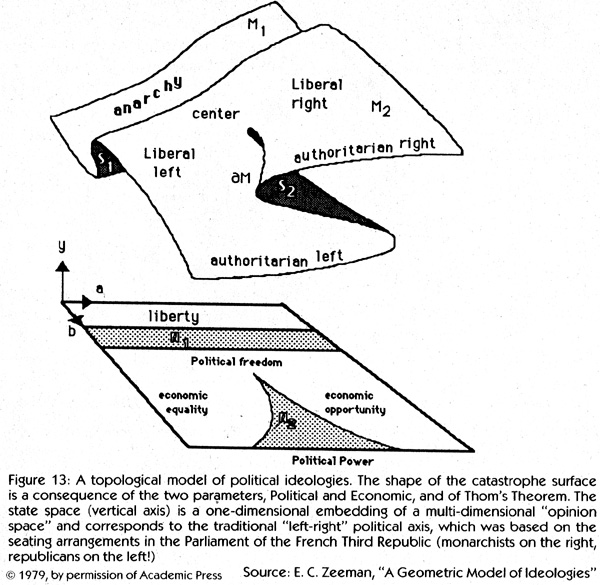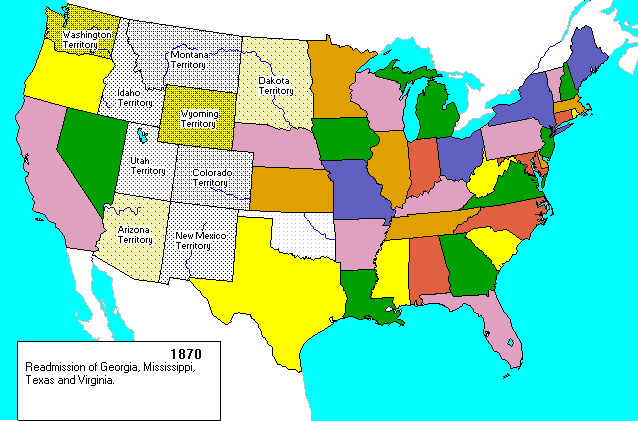I used to get email notifications of comments on these posts. For some reason that has stopped, and I haven't figured out how to restart it.
The OFloinn's random thoughts on science fiction, philosophy, statistical analysis, sundry miscellany, and the Untergang des Abendlandes
Tuesday, November 24, 2020
Comments
Sunday, November 22, 2020
Putting On My Top Hat
Politics these days seem based more on feelz than on thoughts. Now that the shouting is over -- Biden won, so there are no mobs raging in the street -- and the only sound is the high-pitched whine of a well-known Narcissist. TOF thought to take a moment to review the awful simple-mndedness of standard political thought; to wit, the Left-Right spectrum.
Catastrophe Theory was devised by topologist Rene Thom to model situations where stable behavior suddenly flips to chaotic behavior (and vice versa). These surfaces have been used to model such diverse phenomena as the collapse of nations, the buckling of a beam, the binging of anorexia, the flight/fight of animals, boiling of liquids, et al. According to his Fundamental Theorem, there are seven elementary catastrophe surfaces, classified by the number of independent variables and the number of dependent variables. The behavior of a system governed by a potential function converges to an equilibrium surface, the manifold dM. The bends of folds of this manifold describe the varied behaviors of the system.
Back in the 70s, E. C. Zeeman applied the cusp model to political ideologies. The two parameters were A economic (opportunity versus equality) and B political (the rights of the individuals versus the rights of the group). The state space was a “cloud of points” representing the opinions of the individuals in the society. (These are measurable, at least in theory, by opinion polling.) The cloud was embedded topologically in a one-dimensional space, Y, which turned out to be the traditional left-to-right political spectrum. Zeeman‘s catastrophe surface shows why this simple line really has a complex “anatomy”.
An authoritarian left regime that moves toward economic opportunity without opening up politically is liable to snap suddenly to an authoritarian right regime. But if it moves first toward political freedom, it can transition gradually to an open economy. As a society moves smoothly around the parameter space (AxB at bottom) its equlibrium state moves about on the manifold above. For each position in parameter space there is a single unique state on the manifold... Until the society enters the bifurcation set (triangular region) where there are two equilibrium states. Inertia keeps it on the original sheet until it exits the bifurcation set on the opposite side. The original equilibrium vanishes and, governed by the potential function, snaps rapidly to the other equilibrium.
Projecting the surface dM onto the AY and BY planes reveals why dictatorships of the left and the right resemble each other so closely, and why right-wing populists often sound like left-wingers. It also shows why some social changes must be revolutionary; and why one-party states frequently develop left and right wings within the Party.
In 2016, both "tea party" activists and "occupy movement" activists made the same diagnosis of America's ills: viz., the government was controlled by "oligarchs." However, they differed in their solutions. The one wanted to give the government more power (to be wielded, one supposes, by those self-same oligarchs), while the other wanted to elect a junior varsity oligarch.
Wednesday, November 18, 2020
In the Belly of the Whale
TOF has begun working on a new Novel, if you will pardon the redundancy. It is set upon a generation ship traveling toward Tau Ceti at sublight speed. It will be set about 14 or 15 generations into the voyage, when the original constitution of the Whale's society is beginning to crack. By this I don't mean a written Constitution, though there is one, but more like how the society is constituted. What follows is a very rough draft of the Introduction. It's final version may differ considerably, depending on how things go from here. I'm thinking it will be an omniscient narrator and perhaps interleaved chapter of different kinds. We shall see.
Faint beneath the azure sky twilight bells do peal
Midst ruins where their echoes tone:
We were real. We were real. We were real.
As once they were, when life enfleshed these bones
And they fared forth to find what stars conceal.
– Méarana Harper, Bailéad an Domhain Terra.
Prologue
All this happened a great long time ago, by which we mean not only that it was long ago but also that it was great. It was an age of drama and romance. People dared greatly and they failed greatly. At times, they even achieved greatly. This is the story of one of their achievements. As well as one of their failures, as they are often the same.
They called the ship “The Whale” both because it was large and because it was destined for Tau Ceti. It was one of those dreams that they dreamed greatly. The Whale was built from a hollowed-out asteroid to provide spacious habitation for the travelers. Its manifold decks were stocked with all manner of good things: with power and light; with gravity plates; with water and air meticulously recycled; and with plants and animals (both manifest and eminent). The voyageurs needed an ecosystem entire to sustain them, for this journey would be no short jaunt, and those who raised the farther shores would not be those who cast free of Earth. They volunteered not only themselves but their children’s children’s children for, swift as the Whale would fly, twelve light years is a damned long slog.
This was in the days of the Audorithadesh Ympriales. Brethidiendy Miwell II attended the launch in his own person to bid them dyos. Orators spoke, women wept, strong men sighed. Children cheered and danced in the sunlight. Fireworks soared and burst and paper dragons capered through the throngs. Far above, the Whale cast loose from the Beanstalk and the solar powersat lasers beamed gigawatts of power into it. Then everyone went home and after a few centuries had passed, forgot entirely that there ever had been a “Whale.”
In the time after, bones piled upon bones beneath the grass, cities fell and new ones rose, ashes blew in the wind, and names that once did grip the heart in ice faded to musty memories. Can there be forgotten memories? Perhaps those are the happier kind.
Meanwhile, the Whale hurtled on. People aged and died and their children after them. Farms and industries flourished, or not. Vendors haggled. They never forgot they were aboard a vessel, but after a while, they ceased to care.
The Planners had thought of every small thing. They had even written a constitution for the Whale, devised by the best social technicians Earth had to offer, laying out the duties and authorities of every rating and rank on board. They had accounted for every contingency; but they had forgotten one large thing.
Those aboard would be human beings.
###
Sunday, November 15, 2020
Before the Singularity
We saw earlier that by the 1920s, people in the Cities of the West were familiar with automobiles, telephones, electricity, aeroplanes, radio, and a host of other contrivances that surround us still today. (Radios would later acquire picture tubes, to become TVs. Aeroplanes would lose their propellers and become jets. And so on.) But the change from something to something more is merely quantitative while the change from nothing at all to something is qualitative. There is a greater gulf between a horse-and-buggy and a Model T than there is between the Model T and a Maserati. While urban life in 1970 would have been familiar (if amazing and hectic) to someone suddenly transported then from 1920, urban life in 1920 would have been gob-smackingly incomprehensible to someone from 1870.
This vast 1870-1920 upheaval (or singularity) in urban lives barely touched the rural areas. John B Hammontree farmed in 1920 little differently than his grandfather John H Hammontree had farmed in 1870. John Deere had begun selling the motorized tractors only in 1918.
The World of 1870
In 1870, the Civil War has been over for barely five years, and GAR veterans are everywhere. Feelings still run high, and Reconstruction holds sway in the South. The last of the soi-disant Confederate States will be readmitted this year: VA, MS, and TX. Even if some are still Territories, all the present-day States have their current boundaries, except for the Dakotas, which are still undivided. Alaska had been purchased three years ago. The Kingdom of Hawaii is still independent. The Indian Territory is 'unorganized': or as we say now, "off the grid." The Choctaw, Chickasaw, Creek, Seminole, and Cherokee Nations, collectively called "The Nations" in what is now south/eastern Oklahoma were quasi-independent mini-states more self-governing than the Reservations. The First Great Depression is still six years in the future. Senators are still appointed by their State legislatures. Women cannot vote. In 1870, John D. Rockefeller will form Standard Oil, the XV Amendment grants African Americans the right to vote, and over in Europe, the Franco-Prussian War breaks out, leading to the formation of the Second Reich from a passel of Germanies. Standard Oil made its bones cracking the vast lake of oil underneath Ohio into valuable kerosene. The lake of oil under Texas has not yet been discovered, let alone its aptness for making gasoline. It is still "a world lit only by fire." Edison's incandescent light bulb will not be patented for nine years.
Things we take for granted today were not yet on the radar screen. Indeed, the metaphor 'on the radar screen' would have made no sense in 1870. Hershey's milk chocolate had not yet been formulated. H.J. Heinz had not yet invented ketchup. Kellogg's corn flake is 24 years yet to come. Marconi has not been born, so radio is not even a dream. Only by the end of the '70s, will Karl Benz have invented the internal combustion engine. It has been only sixteen years since the Philadelphia half of Pennsylvania has been connected to the Pittsburgh half by the completion of Horseshoe Curve. Railroads, steamships, still photography [30 years old], and wired telegraphy [40 years old] exist, but Jacquard looms running in France off punched cards are not yet applied to tabulation, let alone computing. Almost nothing existed that we associate with modern life.
Wednesday, November 11, 2020
At the Eleventh Hour...
... of the 11th day of the 11th month of 1918, the guns in
Europe fell silent at last. In three-and-a-half years, the Allies in WW1 suffered deaths amounting
to 103 Vietnam walls. That's just over 2.5 Vietnam walls every month. This is my annual Veteran's Day post.
 |
| Harry Singley, TOF's grandfather "Guv" |
 |
| Harry Singley, 304th Engineers, Rainbow Division |
It was some life. I am proud that I went through
it, for nobody on the Hill [i.e., Fountain Hill, PA] will have anything on me... I was a little
with sneezing or tear gas. It made me sick but I remained with the
company for I did not like to leave my detachment at any time for if
something would happen, I thought, there would be plenty of help. I
felt much better in a few days. A small piece of shrapnel splinter hit
me below the knee. Otherwise I was lucky. ..."
#
Prometheus Awards: Read & Watch
Hello Friends & Fans of Michael Flynn, The Libertarian Futurist Society has made available the text of the acceptance speech Dad...

-
TOF once wrote an article entitled "The Great Ptolemaic Smackdown and Down 'n Dirty Mud-Wrassle" which described the century-l...
-
Hello family, friends and fans of Michael F. Flynn. It is with sorrow and regret that I inform you that my father passed away yesterday,...
-
Hello Friends & Fans of Michael Flynn, The Libertarian Futurist Society has made available the text of the acceptance speech Dad...




